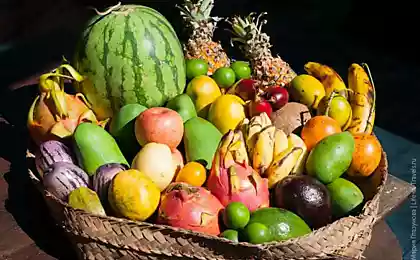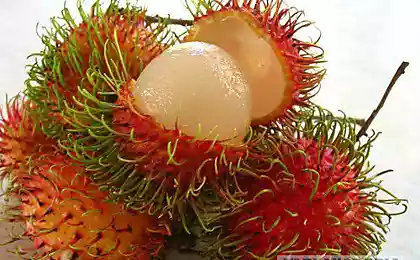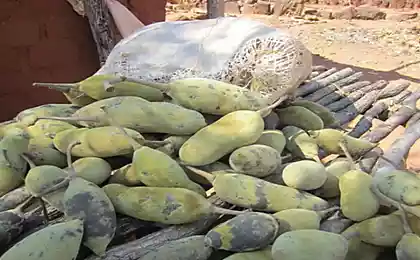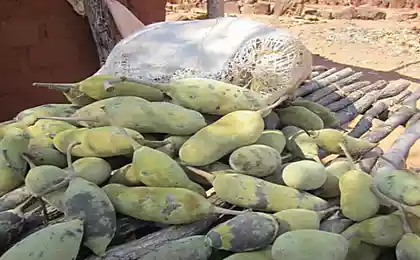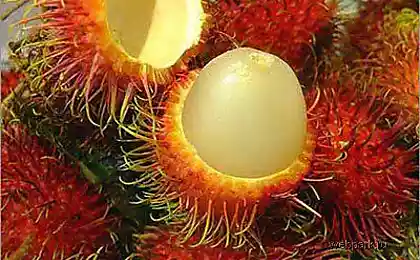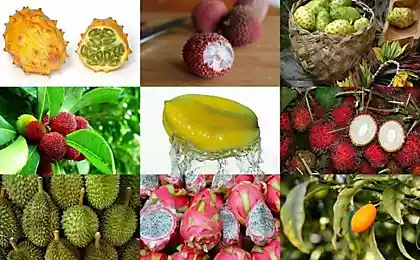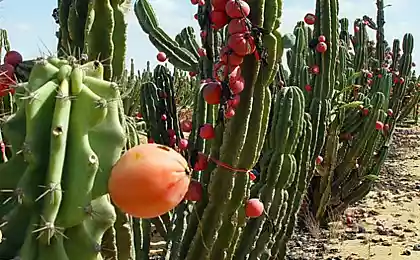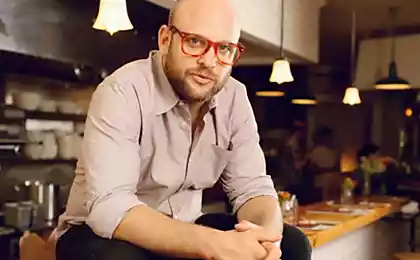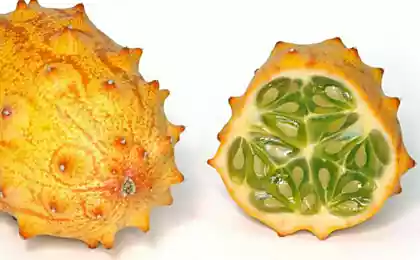525
Mangosteen is the most delicious and healthy fruit
Sixty one million five thousand three hundred eighty six
The most delicious fruit in the world rightly referred to as mangosteen (mangosteen or Garcinia Latin name Garcinia mangostana). The size of fruit size of a small tangerine, has a purple skin and white flesh similar to a delicate cream dessert…
Mangosteen — tall evergreen tree up to 25 m with a pyramidal crown and black-and-brown bark. Leaves ovate-oblong, dark green above and yellow-green bottom, 9 — 25 cm long and 4.5 — 10 cm wide. Young leaves pink. Flowers with fleshy green with red spots on petals. The fruit is round with a diameter of 3.4 — 7.5 cm, covered with a thick (1 cm), maroon-purple inedible containing coloring gummy latex skin, beneath which is 4-8 segments of the white edible pulp with a skintight to her seeds. The plant bears fruits later — the first fruit trees at 9-20 year of life.
The birthplace of the mangosteen from Southeast Asia. Widely cultivated in Thailand, Myanmar, Vietnam, Cambodia, Malaysia, India, Sri Lanka, the Philippines, the Antilles, Central America, Colombia, tropical Africa
Oddly enough, but in the wild mangosteen is not found, it is known only as a natural cultivar. It is believed that this is just a whim of nature — a natural hybrid of two related species (Garcinia hombroniana and Garcinia malaccensis), aromatic polyploid, morphologically combines qualities of both parents. The name "polyploid" means a genetic change associated with the fold increase of the basic number of chromosomes in body cells.
Polyploidy is widely distributed in plants. Usually polyploid plants of larger dimensions, increased content of several substances, the best resistance to adverse environmental conditions.
But the main mystery of the Queen of fruits: mangosteen is asexual — this plant reproduction occurs without vmeshatelstva mujkic cells, all the flowers are both male and female, able to pregnant. Is a very rare natural phenomenon called parthenogenesis. Not formed its flowers and nectar, attracting native pollinators, so during flowering, our Queen is in splendid isolation — insects and birds do not cause her even a simple courtesy call.
Good mangosteen must be large and dense to the touch, but nevertheless slightly soft bounce when you touch the fruit. Do not take a little fruit, as they contain less pulp. Fruit, firm to the touch, dry, chapped skin is already overdue. Circular motion cut the mangosteen at the top, try not to touch the flesh. The cuts can be done on the sides and bottom of the fruit then the peel is carefully removed. Mangosteen can be stored in the refrigerator for one to two weeks.
The beneficial properties of the mangosteen
Mangosteen is the source of the most important human elements: vitamins C and E, Riboflavin, thiamine, nitrogen, calcium, magnesium, zinc, sodium and potassium. And thus, she has a very low level of acid-alkaline balance (pH) – total 3.2.
Thais eat a mangosteen in a raw form, as well as the "bed" of crushed ice. In this kind mangosteen has a very refreshing taste, especially after hot and spicy food. Mangosteen can be filling for pies, add the fruit and spicy fruit salads, milk shakes, cook with the pulp of mangosteen soufflé, and curry sauces for fish. A light, delicate taste. goes well with seafood, especially squid and shrimp.
For medical purposes mangosteen is used for diarrhea. The flesh remaining on the peel to clean, cook and prepare this healthful tea. Alternatively, the flesh can be baked, then soaked in water and add to the mashed potatoes, which is to be every two hours. Mangosteen is very rich in calcium, phosphorus and vitamins B and C.
Mangostin and used in pharmacology. Almost everyone knows about the antioxidant properties of vitamins C and E, however, much less people are aware of the incredible capabilities of xanthones – natural chemical substances, which recently were discovered by scientists.
In a careful study of the medical capabilities of xanthones, it was discovered the following pharmacological properties:
Maintaining microbial balance;
Protection of the immune system;
Improve the overall adaptability of the organism to the external environment;
Ensuring good mental activity.
But what is most interesting is that not only the inner flesh, but the whole fruit as a whole, is yet the only known source of this substance is representative of a new generation of strong phytonutrients that has yet to change the future of dietary supplements.
Source: www.joker-6.ru/post281260620/
The most delicious fruit in the world rightly referred to as mangosteen (mangosteen or Garcinia Latin name Garcinia mangostana). The size of fruit size of a small tangerine, has a purple skin and white flesh similar to a delicate cream dessert…
Mangosteen — tall evergreen tree up to 25 m with a pyramidal crown and black-and-brown bark. Leaves ovate-oblong, dark green above and yellow-green bottom, 9 — 25 cm long and 4.5 — 10 cm wide. Young leaves pink. Flowers with fleshy green with red spots on petals. The fruit is round with a diameter of 3.4 — 7.5 cm, covered with a thick (1 cm), maroon-purple inedible containing coloring gummy latex skin, beneath which is 4-8 segments of the white edible pulp with a skintight to her seeds. The plant bears fruits later — the first fruit trees at 9-20 year of life.
The birthplace of the mangosteen from Southeast Asia. Widely cultivated in Thailand, Myanmar, Vietnam, Cambodia, Malaysia, India, Sri Lanka, the Philippines, the Antilles, Central America, Colombia, tropical Africa
Oddly enough, but in the wild mangosteen is not found, it is known only as a natural cultivar. It is believed that this is just a whim of nature — a natural hybrid of two related species (Garcinia hombroniana and Garcinia malaccensis), aromatic polyploid, morphologically combines qualities of both parents. The name "polyploid" means a genetic change associated with the fold increase of the basic number of chromosomes in body cells.
Polyploidy is widely distributed in plants. Usually polyploid plants of larger dimensions, increased content of several substances, the best resistance to adverse environmental conditions.
But the main mystery of the Queen of fruits: mangosteen is asexual — this plant reproduction occurs without vmeshatelstva mujkic cells, all the flowers are both male and female, able to pregnant. Is a very rare natural phenomenon called parthenogenesis. Not formed its flowers and nectar, attracting native pollinators, so during flowering, our Queen is in splendid isolation — insects and birds do not cause her even a simple courtesy call.
Good mangosteen must be large and dense to the touch, but nevertheless slightly soft bounce when you touch the fruit. Do not take a little fruit, as they contain less pulp. Fruit, firm to the touch, dry, chapped skin is already overdue. Circular motion cut the mangosteen at the top, try not to touch the flesh. The cuts can be done on the sides and bottom of the fruit then the peel is carefully removed. Mangosteen can be stored in the refrigerator for one to two weeks.
The beneficial properties of the mangosteen
Mangosteen is the source of the most important human elements: vitamins C and E, Riboflavin, thiamine, nitrogen, calcium, magnesium, zinc, sodium and potassium. And thus, she has a very low level of acid-alkaline balance (pH) – total 3.2.
Thais eat a mangosteen in a raw form, as well as the "bed" of crushed ice. In this kind mangosteen has a very refreshing taste, especially after hot and spicy food. Mangosteen can be filling for pies, add the fruit and spicy fruit salads, milk shakes, cook with the pulp of mangosteen soufflé, and curry sauces for fish. A light, delicate taste. goes well with seafood, especially squid and shrimp.
For medical purposes mangosteen is used for diarrhea. The flesh remaining on the peel to clean, cook and prepare this healthful tea. Alternatively, the flesh can be baked, then soaked in water and add to the mashed potatoes, which is to be every two hours. Mangosteen is very rich in calcium, phosphorus and vitamins B and C.
Mangostin and used in pharmacology. Almost everyone knows about the antioxidant properties of vitamins C and E, however, much less people are aware of the incredible capabilities of xanthones – natural chemical substances, which recently were discovered by scientists.
In a careful study of the medical capabilities of xanthones, it was discovered the following pharmacological properties:
Maintaining microbial balance;
Protection of the immune system;
Improve the overall adaptability of the organism to the external environment;
Ensuring good mental activity.
But what is most interesting is that not only the inner flesh, but the whole fruit as a whole, is yet the only known source of this substance is representative of a new generation of strong phytonutrients that has yet to change the future of dietary supplements.
Source: www.joker-6.ru/post281260620/
